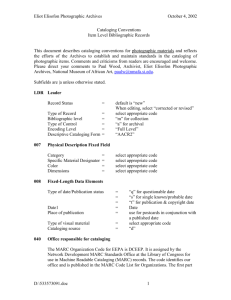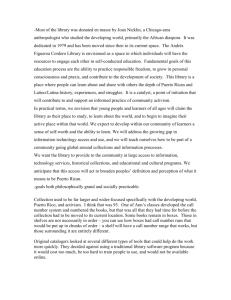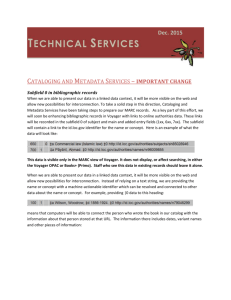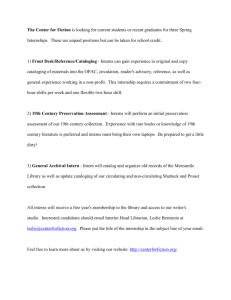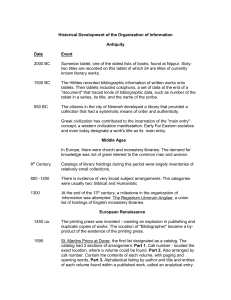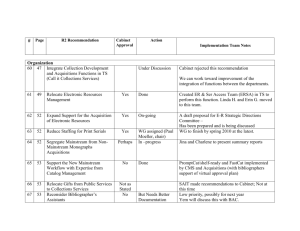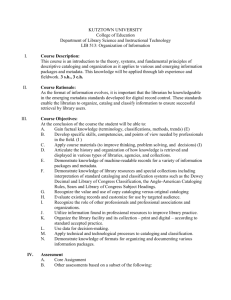Cataloging Conventions - Smithsonian Institution
advertisement
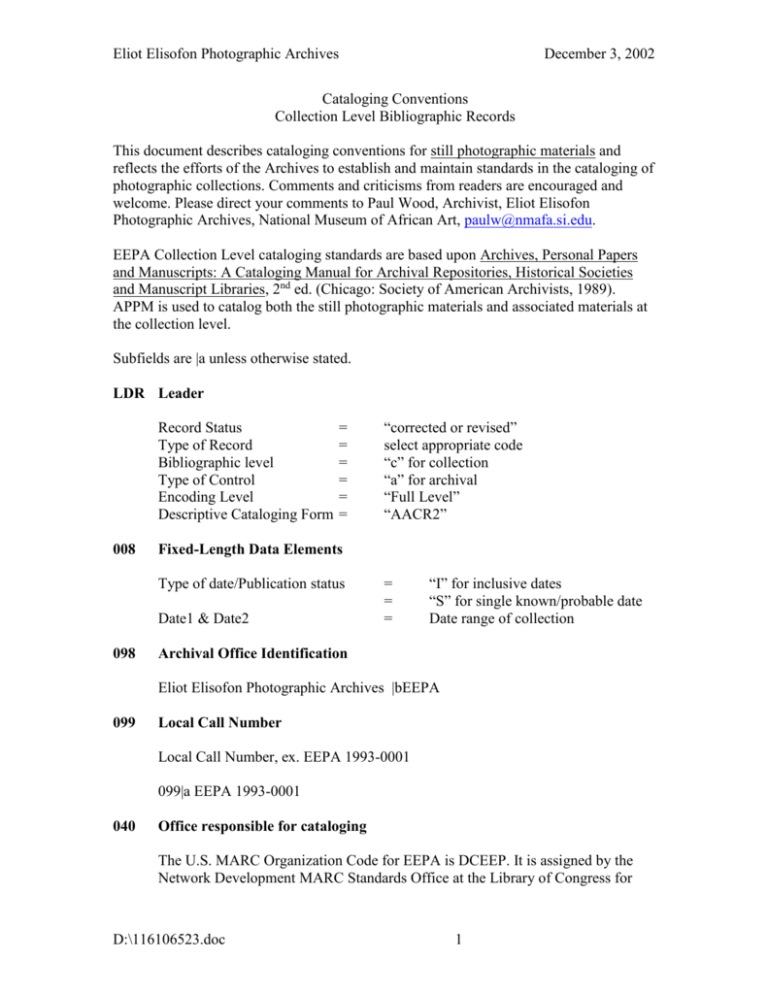
Eliot Elisofon Photographic Archives December 3, 2002 Cataloging Conventions Collection Level Bibliographic Records This document describes cataloging conventions for still photographic materials and reflects the efforts of the Archives to establish and maintain standards in the cataloging of photographic collections. Comments and criticisms from readers are encouraged and welcome. Please direct your comments to Paul Wood, Archivist, Eliot Elisofon Photographic Archives, National Museum of African Art, paulw@nmafa.si.edu. EEPA Collection Level cataloging standards are based upon Archives, Personal Papers and Manuscripts: A Cataloging Manual for Archival Repositories, Historical Societies and Manuscript Libraries, 2nd ed. (Chicago: Society of American Archivists, 1989). APPM is used to catalog both the still photographic materials and associated materials at the collection level. Subfields are |a unless otherwise stated. LDR Leader Record Status Type of Record Bibliographic level Type of Control Encoding Level Descriptive Cataloging Form 008 = = = = = = Fixed-Length Data Elements Type of date/Publication status Date1 & Date2 098 “corrected or revised” select appropriate code “c” for collection “a” for archival “Full Level” “AACR2” = = = “I” for inclusive dates “S” for single known/probable date Date range of collection Archival Office Identification Eliot Elisofon Photographic Archives |bEEPA 099 Local Call Number Local Call Number, ex. EEPA 1993-0001 099|a EEPA 1993-0001 040 Office responsible for cataloging The U.S. MARC Organization Code for EEPA is DCEEP. It is assigned by the Network Development MARC Standards Office at the Library of Congress for D:\116106523.doc 1 EEPA Cataloging Conventions: Collection Level Records use in Machine Readable Cataloging (MARC) records. The code identifies our office and is published in the MARC Code List for Organizations. The first part of the code is a geographic prefix, “DC.” The last part of the code takes letters from the name of the organization, “EEP.” It is always capitalized. 040|a DCEEP |c DCEEP 040|a DCEEP (cataloger) |c DCEEP (transcriber) 100 Creator Name of the photographer, if known. Follow the proper name with the type of media found in the collection, all letter lower case. In this case, follow APPM cataloging conventions; i.e. spell out media type when only one or two types exist, in all cases, use the term collection, i.e. Blake Robinson photographs and postcards or Phil Ravenhill collection. If the photographer is unknown, but the owner of the studio is known, the studio owner is usually credited with the photograph. For postcards, list the printer or publisher when the photographer is unknown. If the photographer is unknown, name the collection after the ethnic or country affiliation, first letter of every word capitalized. Choose whichever best reflects the collection, i.e. Igbo photographs or Nigerian photographs. MARC only allows one creator in the field. Other creators are placed in field 700. If there are multiple creators, the name entered should be the first named or, if that is not given, the senior responsible party. 245 Title Full name of the photographer, if known, with the first letter of each word capitalized, i.e. First, MI, Last, Suffix. When different variations or different names for the same person exist, follow cataloging conventions for MARC 100 field, creator, and use the name by which the photographer was best known. 245|a Sujatha Pelletier photographs. When the photographer is unknown, name the collection after the ethnic affiliation of the country. Choose whichever best reflects the collection. 245|a Igbo photographs 245|a Nigerian photographs D:\116106523.doc 2 EEPA Cataloging Conventions: Collection Level Records Follow the proper name with the type of media found in the collection, all letters lower case. In this case, follow APPM cataloging conventions; i.e. spell out the media type when only one or two types exist. In all cases use the term collection. 245|a Blake Robinson photographs and postcards. 245|a Phil Ravenhill collection. 245|f Inclusive dates The time period over which the material spans. Always give the date as the last item n the title. For open collections which are still receiving material, give the earliest date of the material followed by a hyphen and the word “ongoing” in square brackets. 245|a Postcard Collection, |f 1898-[ongoing]. 245|g Bulk dates The dates for which the materials bulk are largest or are most significant; use only with the inclusive dates and enclose in parenthesis and precede with the word bulk. 245|a Postcard Collection, |f 1898-[ongoing] |g (bulk 1898-1920). 300 Physical description 300|a Extent. The Quantity or number of units described. 300|f Type of unit. The type of photographic material. For a list of terms see Appendix A. There is not punctuation between subfields a and f. The division of the Extent and Type at the collection level allows for reports listing collection quantities, which is an aide in compiling collection statistics. 300|a 128 |f slides : |b col. 300|a 46 |f photographic prints : |b col. 300|b Other physical details Indicates whether the images are color (col.) or black and white (b&w). Precede the subfield with a colon. D:\116106523.doc 3 EEPA Cataloging Conventions: Collection Level Records 300|c Dimensions. The size of the image is always height by width and expressed in centimeters unless a standard English ruler size is used. Precede the subfield with a semicolon. When the image is described as a slide in subfield |a, then the size is understood to be 35 millimeter and does not require cataloging. 300|a 53 |f photographic negatives : |b b&w ; |c 6 x 8 cm. When sizes of a group of images vary, use the measurement from the largest sized image and add the words “or smaller.” 300|a 26 |f photographic prints : |b b&w ; |c 12 x 16 cm. or smaller. 300|3 Materials Specified Describes the type of photographic materials, i.e. albumen, collotypes, tintype, etc. Also used to note duplicate images with the words, “dupe negs” or “dupe prints.” The originals and duplicate descriptive entries usually appear one following the other. 300|a 26 |f photographic negatives : |b b&w ; |c 4x5 in. |3 silver gelatin. 300|a 26 |f photographic negatives : |b b&w ; |c 4x5 in. |3 dupe negs. 351 Organization and Arrangement of Materials. Describes the organization (groupings or subdivision) in subfield a, arrangement (order or pattern) in subfield b, and hierarchical level of the material in subfield c. Used only for collection level records. 351|b Chronological by region. 351|a Images indexed by negative number. 351|3 film 35 mm: |b arranged numerically by film sheet 351|3 prints: |a organized in 10 boxes; |b arranged numerically by image number 351|3 slides: |a organized in four volumes; |b arranged numerically by image number. 351|3 slides: |a organized in slide filing cabinet; |b arranged numerically by image number. 506 Restrictions on Access Used for physical access restrictions. This includes the terms governing access in subfield a (Restricted) and the physical access provisions in subfield c (Access by appointment only). Use the following standard text line in all collection level records. D:\116106523.doc 4 EEPA Cataloging Conventions: Collection Level Records 506|a Restricted: |c Access by appointment only. 520 Summary Note Narrative description of the scope and content of the collection. Summary should include the photographer, the major subjects, countries and the span of years covered. Subjects should specify the African peoples and activities. Lengthy summaries can be divided in paragraphs among separate 520 entries. 520|a Photographs taken by Susan Vogel in Cote d'Ivoire during the 1970s. 540 Terms Governing Use and Reproductions Note Used for Intellectual restrictions on use including reproduction. Use the following standard text lines when appropriate in all collection level records. Leave blank when no restrictions exist. 540|a Copyright: Sujatha Pelletier, 1995. 540|a Restricted: Donor’s permission required for duplication. 540|a Restricted: For study purposes only; copy photographs not available. 540|a Duplicate images available. 541 Immediate Source of Acquisition Note Source of the collection. 541|a Source Name of the source, “Last Name: Full Name.” This format allows for a report listing donor’s by last name with full name displayed. If an organization, then one may list the organization’s abbreviation followed by the full name. 541|a NCMA: North Carolina Museum of Art in Raleigh 541|b Address Full mailing address of donor. 541|c Method of acquisition Enter either, donation, purchase, loan, transfer or addition.” 541|d Date of acquisition D:\116106523.doc 5 EEPA Cataloging Conventions: Collection Level Records YYYY/MM/DD. In case of a donation or loan, note in parenthesis whether the agreement is “signed” or “unsigned.” 541|e Accession number. When parts of a single collection are received at different times or from different parties, show separate receipts with the suffix –A, -B, -C, etc., on separate 541|e subfields. 541|n Extent Number of images 541|3 Materials specified. Type of images. (Specific Material Designator). When separate film types are received at separate time for a single collection. 541|a Ottenberg: Simon Ottenberg |b2317 22nd Avenue NE, Seattle, WA 98112; |c Donation; |d 200/03/13 (signed); |e2000-0007-A 541|n (225 |3 slides) 541|a Nooter: Robert and Nancy Nooter |b 5020 Linnean Ave, NW, Washington, DC 20008; |c Donation; |d 1999 May 10 (signed); |e1999-0006 541|a IEF: International Exhibition Foundation |b Editors Building, Suite 310, 1729 H Street, N.W., Washington, D.C.; |c Donation; |d 1998; |e 1998-0007 541|a NCMA: North Carolina Museum of Art in Raleigh; |b Raleigh, NC; |c Donation; |d1986 (unsigned); |e 1986-0011 545 Bibliographic or Historical Note Bibliography of a collection creator, especially if the person is unpublished. 545|a Burton E. Ashley, geologist, worked for the British South Africa Company (1930-1933). He received a M.A. degree from the University of Minnesota in 1936 and worked for the Texas Company (1936-1943), Phillips Petroleum Company (1943-1950), U.S. Geological Survey (1950-1957) and the U.S. Bureau of Mines (1957-1960). In 1961, he became minerals officer for the U.S. Department of State, serving in Australia. After retiring, Ashley served as a volunteer in the Mineral Sciences Department of the National Museum of Natural History. 561 Provenance D:\116106523.doc 6 EEPA Cataloging Conventions: Collection Level Records Donated, Purchased, Loaned or Transferred from whom or from where and year. When purchased, do not mention the name of the seller. 561|a 561|a 561|a 561|a 561|a 561|a 561|a 583 Donated by Volkmar Wentzel, 1999. Donated by Robert and Nancy Nooter, 1993. Purchased, 2000. Transferred from the Anchorage Museum of History and Art, 2000. Collected by the Archives Staff, National Museum of African Art. Donated by the estate of Eliot Elisofon, 1973. Originally collected by Ethel Mary who had received them from her husband; maintained by her daughter, Mary Shephard Slusser; Donated by Mary Shephard Slusser as part of a larger collection of postcards to the Freer-Sackler Art Gallery, Smithsonian Institution; transferred to the National Museum of African Art, 2002. Action Note Use this field to record actions not covered elsewhere. These actions include cataloging, acknowledgments, shipping. 583|a Accessioned; |k Paul Wood; |n323; |o slides; |c1997/10/01 583|a Cataloged; |c 2000/09/19; |k Paul Wood. 583|a Shipped; |c 1990/10/26; |f Donation agreement; |k Christraud Geary 583|a Acknowledged; |c 1999/10/19; |I Letter; |k Paul Wood Also, use this field for inventorying of collections. Collections sometimes have more one than one type of material. Therefore, it is necessary to identify the type in subfield o. 583|a Inventoried; |k Paul Wood; |n 356; |o slides; |c2001/11/01 583|a Inventoried; |n 206 |o contact print images; |k Paul Wood; |c 2002/02/05 583|a Inventoried; |n 24 |o color slides; |k Paul Wood; |c 2002/02/05 852 Location, of Materials The information required to find a collection. This field notes the location of the materials described in field 300, Physical Description. Most photographic collections are stored in boxes and volumes. Therefore the number of boxes or volumes, along with their location, is listed here. The types and number of containers should match the description given in field 351, the Arrangement and Description of the collection materials. 852|3 Materials |h Item count |c Shelf location 852|3 box |h 2 |c cabinet A D:\116106523.doc 7 EEPA Cataloging Conventions: Collection Level Records 852|3 volume |h 1 |c shelf F 852|3 box |h 1 |c shelf B In the case of the small collections, the volume number if shown in subfield h, item count. 852|3 volume |h 1 |c shelf F (small collections) Many types of film; slides, 4x5 negatives, and 35 mm. film strips; are filed directly into cabinets. Film cans are stored on shelves. 852|3 film 35 mm |h 312 |c cold room 852|3 film 4x5 |h 26 |c cold room 852|3 cine film |h 4 |c cold room 852 Location, of Archive 852|b Sublocation 852|e Address 852|a Smithsonian Institution, |b National Museum of African Art, Eliot Elisofon Photographic Archives, |e 950 Independence Avenue, S.W., Washington, DC 20560-0708 D:\116106523.doc 8
